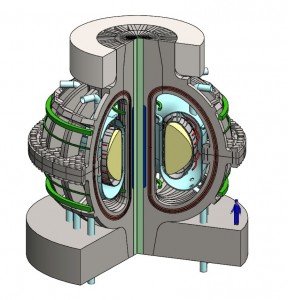MIT Nuclear Fusion Work Revived for Now
-
-
slice.mit.edu
- 1
Filed Under
Recommended

Guest Blogger: Peter Dunn
Making nuclear fusion a viable option for producing electricity is a big challenge with big upside—emission-free energy with virtually unlimited fuel supplies and no long-term waste management issues. MIT’s fusion research team has faced another big challenge in recent years, in the form of a planned federal funding cutoff, but the group gained new life with Congressional restoration of $22.5 million in the 2014 US budget.
While future federal funding is still a question mark, MIT faculty are quick to note the program's educational and research value and its central role in building a global infrastructure of fusion capabilities and knowledge.
One argument for shutting down the Institute program is that scarce funding is better devoted to the International Thermonuclear Experimental Reactor (ITER), a major collaborative facility being built in France. But Nuclear Science and Engineering Professors Dennis Whyte and Anne White note that MIT’s Plasma Science and Fusion Center—and its Alcator C-Mod fusion reactor—represent an essential resource for the ITER effort: the world’s only facility capable of creating simultaneously the same magnetic field, plasma shape and density, and power flow intensity as ITER’s planned reactor, which incorporates multiple design features from Alcator in substantially scaled-up form.
“That’s why the ITER team comes here, because you can run experiments that you literally can’t run anywhere else,” says Whyte. “You need something like this during the entire lifetime of ITER; it’s hugely cost-effective compared to running experiments there.” White adds that Alcator is also an ideal environment for development of diagnostic hardware and instrumentation for ITER.
The two researchers also point to an important next step for fusion: the design of actual power plants, an area of unique strength for MIT, with its well-integrated nuclear engineering, plasma physics, and materials science programs.
“This is the roadmap every country wants for fusion,” says White. “To see existing devices inform ITER, and in parallel, develop reactor prototypes to probe the integration challenges of plasma physics, materials, boundary physics, and nuclear technologies. There are so few options on the table; fusion really has to be part of the world’s energy research portfolio.
A paper being prepared for publication by Whyte’s research team, consisting mostly of MIT graduate students, offers a conceptual power plant design utilizing new-technology superconducting magnets and novel RF power coupling methods to match ITER’s 500MW output in a much smaller reactor (see figure).
More broadly, adds Whyte, MIT has outsized influence on fusion research. “Per dollar spent, we have the highest citation rate among US fusion labs, and we get a huge number of presentation invitations,” he notes. “We’ve won two of the last five annual prizes for most influential paper awarded by the worldwide journal Nuclear Fusion, and our PhD students have won two of the last four American Physical Society awards for best thesis. We receive roughly one percent of worldwide fusion funding, but we’re helping move the whole field forward.”








Comments
linda
Thu, 07/17/2014 4:45pm
Very good news.